The third battle in the Malaya 1942 campaign fought between Leith and John (that's me) using Chain of Command. With a major victory to the Australians in the first game and a minor victory to the Japanese in the second game the Australians had been pushed back closer to Singapore. The third battle was to be fought on campaign map 2.
I had brought all my based jungle trees and bushes to add to Leith's. Unfortunately I forgot to bring the loose scatter bushes to add in between the trees. So the table looks sparser than previously. Note that it is still mostly primary jungle except for the roads, village, bamboo forest section and secondary jungle section. Due to the missing scatter bushes we used fences to define the edges of the cleared village terrain, but these would not affect movement nor provide additional cover.
JAPANESE PLATOON 2
The Japanese 2nd platoon led by the sociable Rikugun (Lt.) Fujita and Gunsō (Sergeant) Haregawa carried forward from their victory in the last battle. However, rifle squad 1 leader Aoki-san and rifle squad 2 leader Matsuda-san were out of the campaign and had to be replaced.
With casualties, the 2 promotions and some replacements, this left the Japanese platoon a total of 5 men short. 4 other men were absent recovering from the last battle and would return for the next turn.
The CO’s opinion of Fujita-san is +1 due to the victory. His men’s opinion is -5 due to the large casualties in gaining the victory. Including the +1 for the campaign, this results in an overall +1 on the Force Morale roll for Japanese in the third battle.
Rifle squad 1 was now to be led by Amatatuda-san, a 23-year-old loyal supporter of the Emperor.
Rifle squad 2 was now to be led by Yatamura-san, a 27-year-old weaver from northern Hokkaido.
These promoted men would have only 1 command point and a 3” command range, giving reduced command to the Japanese for this battle. If they survived the battle, Leith would roll a D6 and on a 3 to 6 they would learn from their experience, be accepted by their men and become a normal Junior Leader with 2 command points.
AUSTRALIAN PLATOON 1
The popular Lieutenant Kenneth Reid gained a +1 force morale. His CO’s opinion was +2 and his men’s opinion of him was +2.
The Australian platoon was 3 men short from casualties in the first two battles. They also have 2 men in hospital who will return for turn 4.
MAP
The battle was to be fought using scenario 2 from the Chain of Command rulebook. The Japanese have passed the defile and can now attack the Australians using the main road or a secondary road.
Rolling 3 times on the campaign terrain table gave us a village, a bamboo forest and some secondary jungle as shown on the map. North is approximately to the top of the map.
 |
| Malaya 1942 Campaign - Map - Turn 3 Battle 3 |
SUPPORT
Leith rolled low, so the Japanese platoon ended up with only 1 support point. This did not allow him anything useful.
The Australians gained 3 support points due to the difference between the two platoons. There were no adjustments. I decided to bring in a Lanchester armoured car. I felt safe with this as Leith could not afford any tanks (phew). It has a 0.50 cal and two 0.30 cal machine guns. Which is pretty handy.
But the main reason was that I had recently modified a Rolls Royce design and 3D printed an approximation to a Lanchester.
See https://www.thingiverse.com/thing:769137 for the Rolls Royce armoured car (and lots of other AFVs by m_bergman on Thingiverse.
When first looking through the campaign a couple of weeks ago I had notice the Lanchester mentioned. I had never heard of this before and looked it up. Not too different from a Rolls Royce armoured car, which I knew a little about. Lanchesters were pretty well outdated in Europe by the 1930s so they were sent to the far reaches of the British Empire.
I found a 3D print version of a Rolls Royce armoured car and quickly modified it to approximate the Lanchester with its twin rear axles, different turret and different machine guns. You will notice some differences. Mainly the rear tray looks too long and the mudguard is not rounded at the front. It was going to take too much 3D drawing effort to do an exact model by extending the cabin rearwards and moving the turret rearwards, but it gives a good impression of the Lanchester. A couple of 3D prints later and both Leith and I had a pair of “pseudo” Lanchesters that we were happy with. The photo below shows my 2 Lanchesters with the painting partly complete.
FORCE MORALE
Obviously pleased after their victory, the Japanese ended up with 11 for Force Morale. The Australians only ended up with 9, which would make them a little more fragile than their enemy. Especially when you consider the -1 to the “Bad Things Happen” dice rolls that the Japanese get in this campaign to reflect their confidence.
PATROL PHASE
In this scenario the Australians start their 4 patrol markers 12” from the baseline and can be spread out. You have to be careful not to start them too far apart as this restricts where you can move to initially. The Japanese started with their 4 patrol markers in a pile at some point on their baseline after the Australians had placed theirs.
In the campaign the Japanese can move their patrol markers 14” and be 14” apart to represent their preparedness for this campaign. The Australians use the standard 12” patrol distance.
The Japanese concentrated on pushing down the eastern side but were stopped just in time by the Australians. We learnt that sometimes it is a mistake to place a patrol marker closer than 6” to a side edge as this may preclude the placing of a jump off point. We were not sure if you could bend the 6” along the side edge towards the player’s baseline, so decided not to allow it. One to check on the forum. In the photo the white circles show the position of the Japanese jump-off points and the blue the Australian.
BATTLE
Turn 1 Phase 1
- The Japanese force starts with the initiative in most battles in this campaign. They began with a roll of 1, 1, 2, 4, 6 for command.
- Gunsō (sergeant) Haregawa arrived and brought in the 1st rifle squad.
- Replying with a 1, 4, 4, 5, 6 the Australians did nothing as it would be too dangerous to just bring in a Senior Leader. It would just make him a target.
Turn 1 Phase 2
- Japanese roll command of 2, 3, 5, 6, 6. The next phase will be theirs as well. Hasegawa-san moved the 1st rifle squad forward 7”.
- The knee mortar squad was deployed on the road.
Turn 1 Phase 3
- Japanese roll 1, 1, 2, 2, 5. Leith brought on the 3rd rifle squad.
- The 1st rifle squad continued to move forward, threatening the closest Australian jump-off point. Due to activating with a 2 and not a 3, they could not go onto overwatch.
- With a 2, 3, 3, 5, 5 the Australian 1st section arrived to protect the jump-off point. Their defensive fire was fierce, causing 3 kills and 3 shock on the undermanned Japanese 1st rifle squad.
- With the Australian 2nd section arriving a short time later, the Japanese must have moved to the far side of the trees as they only dealt them 1 shock.
- The arrival of the Lanchester armoured car on the secondary road surprised the Japanese mortar squad. They were a tempting target on the road. But despite being caught in the middle of the road, there were no kills. At least the mortar team gained 2 shock.
Turn 1 Phase 4
- A Japanese command roll of 1, 2 ,3 ,5, 5. Chain of Command points were being amassed by both sides, although it meant less troops movements in these early stages of the battle. • The combined fire of the Japanese 1st rifle squad and the mortar squad killed a rifleman and a Bren gunner across Australian sections 1 and 2.
- With a 2, 3, 3, 6, 6 the Australians would have the next phase as well. This allows a player the opportunity to perform more complex manoeuvres, knowing that you won’t be shot at until after the 2nd phase unless the opponent uses a Chain of Command die to interrupt with one unit. It is also a good opportunity to try moving a long way. Of course, if you don’t activate the unit again in the second phase, it could end up stuck in a precarious position. It can also be used to pour two lots of fire into a unit, with no recovery between unless a Chain of Command die is used.
- Fire poured into the Japanese 1st rifle squad 1 from the 1st and 2nd Australian sections. It was devastating, with Amatatuda-san and 7 others killed plus some shock. With the death of their leader and the squad a shadow of its original, they broke and ran north. Overall the Japanese force morale dropped by 3, despite the -1 adjustment for each roll.
- The Lanchester added to their woes. This time the fire from the HMG and the MMG were more accurate, inflicting 5 kills and 2 shock on the stranded mortar team. Their leader Onishi-san was knocked out, causing the force morale to drop another point.
- Australian force morale was still 9, but the Japanese had dropped from a starting value of 11 down to 7 in this turn.
Turn 1 Phase 5
- Next phase to the Australians with a 1, 1, 2, 4, 5 bringing Chain of Command points to 4 – not a full dice but well on the way.
- Young Lt. Reid removed some shock, ordered the 2nd section to carefully move forward whilst the 1st section covered their advance. Their fire caused 1 kill on the Japanese 3rd rifle squad.
- More fire from the Lanchester brought 2 more casualties and another hit on Onishi-san. This was the 3rd time he was knocked out and again there was no loss of Force Morale for the Japanese. He was lucky that he had not been killed.
- At last the Japanese were able to move the mortar squad off the road and into the heavy cover of the jungle with a roll of 1, 2, 2, 5, 6. They also wounded Corporal Colin Moore who was directing the 2nd section Bren team, reducing the Australian force morale to 8.
Turn 1 Phase 6
- Lots more Chain of Command points for the Australians, but limited and ineffective fire with a command or 1, 1, 5, 5, 5.
- Leith and I had a discussion bout visibility in the primary jungle. The campaign rules suggest 12” plus 1D6” every time visibility distance needs to be checked. This is quite reasonable and has given a good effect so far. What we discussed was when do you check the roll. We decided that you have to activate a team/section/squad first, then roll for visibility. Once you know the visibility you can then decide what you want that team or section/squad to do.
- A good command roll for the Japanese this phase. A 2, 3, 4, 5, 6 allowed the 2nd rifle squad to arrive and fire against the Australians spreading 3 kills and 1 shock against the 1st and 2nd sections.
Turn 1 Phase 7
- The Australian command roll of 1, 3, 4, 5, 5 was interrupted by the Japanese using their Chain of Command die. The result was a satisfying 3 kills and 2 shock across the Australian 1st and 2nd sections.
- Again the Australian leaders were able to reduce shock on their teams.
- The 2nd section returned fire, killing a rifleman and wounding Kojima-san without impact to Japanese force morale.
- Only a shock on the 3rd squad from the reduced fire as Corporal Brian Evans carefully moved his section forward.
- The Lanchester began driving up the road. Bumping and rattling along the rough secondary road reduced the accuracy of its machine guns against the mortar squad now in cover in the jungle.
- Responding with 1, 2, 2, 4, 6 only allowed the Japanese to reduce one shock and inflict one on the Australians. With one leader killed, another knocked out and a third losing a command point, the reduced Japanese leadership was limiting their ability to fight effectively.
Turn 1 Phase 8
- With a 1, 1, 3, 4, 5 for command the Australian men concentrated fire on the enemy 3rd squad. Inflicting 3 kills and 2 shock was bad enough, but Kojima-san was hit again, putting him out of action and dropping the Japanese Force Morale to 6. With only 6 men left and 4 shock the squad was close to being pinned, particularly given the further reduced leadership.
- Further fire rattled out from the Lanchester, inflicting 1 kill and 2 shock.
- The Australians brought on a fresh section to safeguard the jump off point just west of the village.
- This was too much for the Japanese. With 24 men out of action, shock piling up, 2 leaders killed and Onishi-san still knocked out, the Japanese withdrew. A good round from the Australians would put their force close to breaking. The Australians now had more men, more command points, a fresh section, minimal shock and the mighty Lanchester.
- Australian Force Morale was 8 to 6 for the Japanese1 higher but with the -1 adjustment the Japanese were harder to drop. So from a campaign point of view the Australians decided they had damaged the Japanese enough. It was risky for them to take too many casualties as they rarely get replacements in the campaign.
WRAP UP
Early casualties to the Japanese riflemen did not help their cause. With less men to shoot back the squad quickly diminished further in size.
Worse was the reduction in Japanese leadership that continued throughout the battle. This made it difficult for the Japanese to activate some units at times. It always made it difficult for them to reduce shock.
Surprising the mortar team in the road and having two consecutive phases of fire against them, before they could dash into the jungle, quickly made them ineffective. Leith had been hoping to race them down the road and off the board to achieve the mission, whilst most of the Australians were fighting in the jungle to the east and west of the road. The appearance of the Lanchester was a great surprise to the Japanese.
CAMPAIGN IMPACT
A second victory to the Australians, causing further delay to the Japanese advance.
With a positive force morale difference of 2, this meant that the 6 Australians “killed” in this battle dropped to 4. This represents the Australians finding and recovering casualties because they were left in control of the field.
This translated to 2 dead, 1 out for the next battle while recovering and 1 returning immediately to the platoon. Already 3 men short from the previous battle, but with 2 now back from hospital, this resulted in the platoon being 4 men short, with 1 in hospital for the next battle.
COs opinion of Lt. Kenneth Reid increased to 3, which will give the Australians +1 support point next game. The men's opinion stayed at 1. Hard to please. Reid's outlook improved from popular to brave which will give +2 on the Force Morale role next game.
With 24 men and 2 squad leaders killed the Japanese had sustained a lot of casualties. Onishi-san had been knocked out more than 2 times. The result would be 12 dead men, 6 in hospital for the next battle and 6 walking wounded returning immediately. In addition, the 2 recently promoted squad leaders Amatatuda-san and Yatamura-san were dead or invalided out of the campaign. A third (Onishi-san) would miss the next battle. 3 men would need to be promoted to replace them.
Despite the ability to receive replacements for the enlisted men before the next battle, having 3 squad leaders with only 1 command point each would hamper the Japanese. More importantly, a single wound would kill them. This would make the Japanese platoon fragile.
So Leith will bring in a fresh Japanese platoon for the next battle which would again be on map 2.
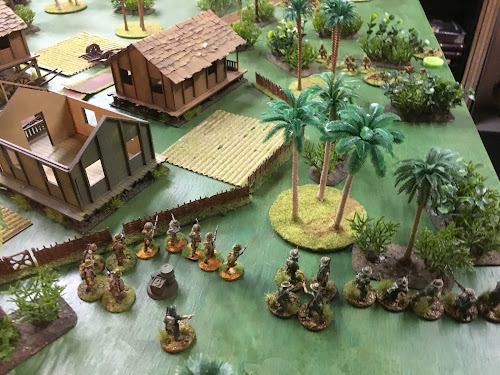

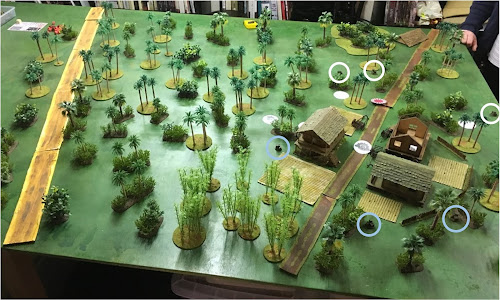

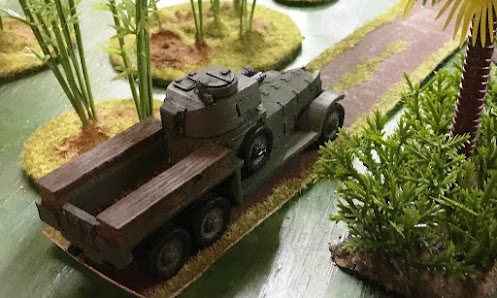
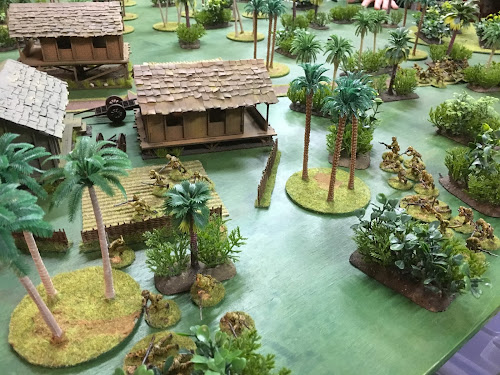

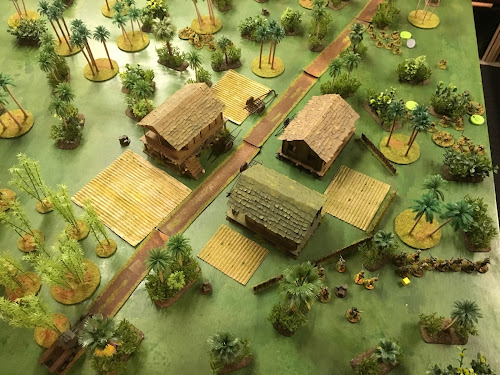


No comments:
Post a Comment